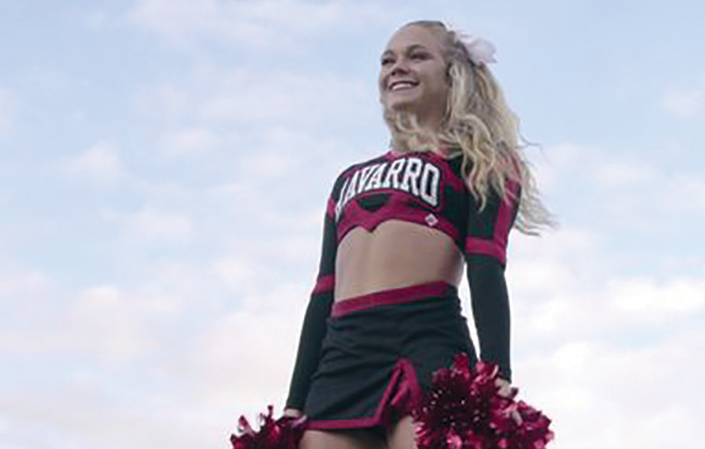Cheer Up!
Using a popular Netflix documentary to make a case for selling cheerleading.

Let’s clear something up right away: Yes, I did binge watch “Cheer” on Netflix last month, but only the first and last episodes. I just wasn’t that interested in the personal exploits of Gabi and Lexi and the rest of the boys and girls. It was certainly compelling documentary work — complete with intriguing back stories, personal angst and enough flipping and falling to entertain even the casual viewer.
But I watched it so you wouldn’t have to spend six hours immersed in the competitive cheer world of Navarro Junior college in the Texas town of Corsicana, best known previously for its fruit cakes. I figured I would write a synopsis of the plot, mention the brands that were highlighted and give me a few stars as an amateur television critic.
But then half way through my two hours on the couch I came to believe it is actually must-see TV for any team dealer or roadman trying – either successfully or not – to understand and sell into the very insular world of cheerleading. Simply put, if you want to understand the girls – and parents and coaches – you are selling to, watch “Cheer.” It is time well spent.
In case you live under a rock and haven’t heard about Cheer – or seen the parody on Saturday Night Live, a true indicator of its current pop status – the series, in the words of The New Yorker, “is a quick, compulsive watch, combining the savage thrill of watching an overdog dominate and the emotional pull of witnessing an underdog’s rise.”
The show revolves around Navarro’s longtime coach Monica Aldama, “a brisk fortysomething with highlighted hair, long-wear mascara, a Texas accent and an M.B.A who rules the program with a fearsomely controlled demeanor interrupted by flickers of maternal warmth.” In the six episodes, “Cheer” documents the lead-up to the College Nationals Competition in Daytona Beach, FL.
The value of “Cheer” to team dealers is that it gives a rare inside look at what drives these young women – and men – and how they most definitely view themselves as athletes and performers equally. Sure, the Navarro cheerleaders stand on the sidelines during the school’s football games, but their lives and practices revolve around the competitions that define them. These are definitely not your parents’ cheerleaders.
Indeed, as CNN opined, “Cheer” is “an invitation to complicate a lifetime’s worth of social messaging about a sport and the athletes who love it.”
Team dealers need to understand that social messaging if they are going to sell cheerleading. This is a sport whose influencers start, literally, at the top of the pyramid and work their way down — to high school cheerleaders emulating the trend setters a level above them, to the recreation squads where the girls on the cheer squad frequently outnumber the boys on the football team.
And it certainly resonates with the incredibly lucrative world of cheer camps and schools, many of which are highlighted during “Cheer” as the proving grounds for tomorrow’s cheer leaders. Scenes in Episode 1 shot inside various cheer schools have to make any team dealer salivate (professionally) at the sight of literally hundreds of girls jumping, soaring, twisting and dancing — all wearing exactly the clothes, shoes, warm-ups and ribbons that team dealers sell. Yes, I said hundreds of them, in dozens and dozens of similar camps and schools across America.
From a business perspective, the twist in the plot came in the final episode when the producers inexplicably took some serious shots at Varsity Spirit – sister company of BSN Sports under the Varsity Bands banner – for its dominance of the competitive cheer business in America. (Ed. Note: The producers of “Cheer” obviously had a bone to pick with Varsity Brands, since the company denied its crew any access to its College Nationals Competition in Daytona Beach. The show had to rely on video shot by contestants and other attendees during the actual event.)
“Varsity controls cheerleading,” one observer claimed. And she didn’t mean it as a compliment.
“Varsity Brands has been very successful in controlling the narrative of cheer,” added author Natalie Adams, who wrote a book entitled “Cheerleader: An American Icon.”
“Control is a strong word,” responded Varsity Spirit president Bill Seely in the documentary. “I don’t apologize for what we do. People choose Varsity Brands because we are genuinely trying to help them be successful in what they want to do,” he adds.
Varsity Brands CEO Adam Blumenfeld admits that the negative treatment Varsity Cheer received in the documentary did have a direct correlation with the fact that Varsity Brands does not allow outside cameras into its facilities or events in order to preserve the environment for the safety of the participants, unless they can come to very specific agreement with the outside party.
“We do appreciate the documentary bringing an acute focus to the athleticism and skill of these young athletes,” he tells Team Insight. “It’s been long overlooked.”
“We do appreciate the documentary bringing an acute focus to the athleticism and skill of these young athletes. It’s been long overlooked,” adds Nicole Lauchaire, senior VP–corporate communications for Varsity Brands. “These young people are true competitors and teammates and are driving spirit in school — throughout their community, as well as competing outside of the schoolhouse.”
“A key priority for … our entire Varsity Brands family is to harness this power of spirit across all three of our businesses to truly make a positive impact in schools and communities,” she continues. “So, while we’re not entirely pleased with every editorial decision in the series, the essential takeaway is one that reinforces so much of what we try to do in schools across the country — showcasing commitment, pride and teamwork. Our job is to channel all of that for good.”
Varsity Spirit undoubtedly does dominate cheerleading in America, just as BSN Sports is attempting to do in the world of team sports. That isn’t a knock on the company or its business practices. It’s a sign of just how focused on its missions the two companies under the Varsity Brands umbrella remain.
Nevertheless, cheerleading still offers opportunities for team dealers to sell their schools and local programs all the things they and their cheerleaders need. With a few notable exceptions, team dealers have ceded the cheer business to the likes of Varsity Spirit and their online competitors, but they still sell plenty of workout clothes, shoes and accessories to those thousands of girls across the country who look at cheer as not a sideline activity, but as a legitimate sport that requires the same commitment as more traditional sports.
Still don’t believe me? Fire up Netflix, settle on to the couch and watch at least part of “Cheer.” At the very least you can claim – as I did to my family – that you are doing research for work. It will be worth your time.






